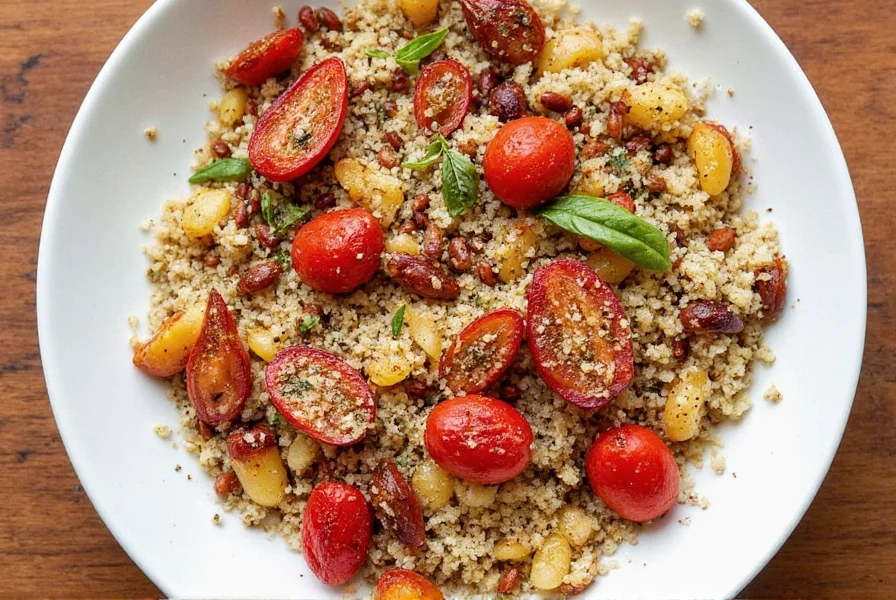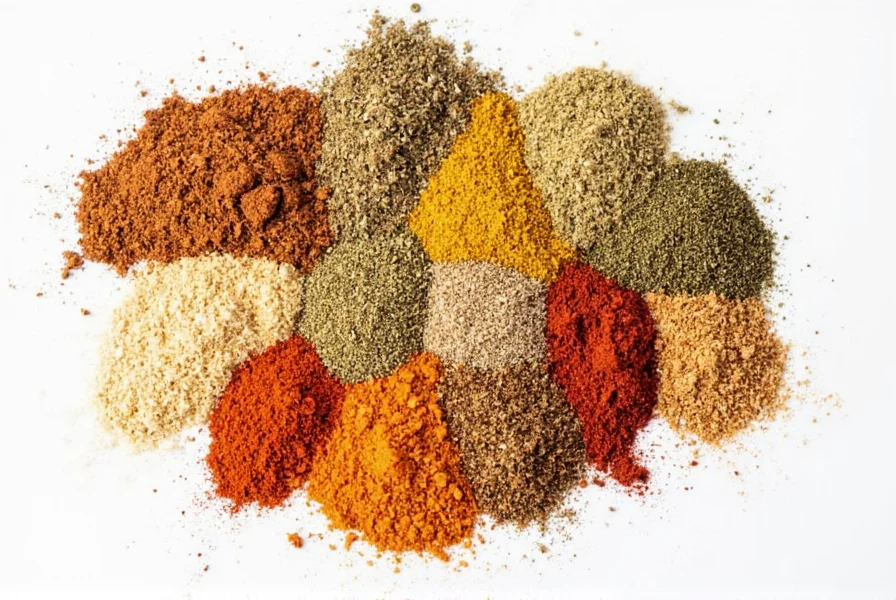Table of Contents
Introduction to Bruschetta Seasoning
Bruschetta seasoning is a simple yet essential blend of dried herbs and spices that brings authentic Italian flavor to bruschetta and countless other dishes. In this comprehensive guide, you'll discover the exact recipe to make it at home, the top 5 store-bought brands for 2025, and expert tips to use it perfectly every time – whether you're making fresh bruschetta, enhancing tomato sauces, or adding a savory kick to dips.

Whether you're a seasoned chef or a home cook with a passion for flavor, understanding bruschetta seasoning can elevate your dishes from good to unforgettable. This guide covers everything you need to know about this essential spice blend — from what goes into it to how to use it, and even where to find the best ones.
Key Ingredients in Bruschetta Seasoning
The standard ratio for homemade bruschetta seasoning is 2 parts dried oregano, 2 parts dried basil, 1 part garlic powder, 1 part onion powder, plus salt and freshly ground black pepper to taste. These ingredients work together to create a balanced flavor profile: oregano provides earthy depth, basil adds sweetness, garlic powder offers savory notes, and salt/pepper enhance all flavors.

Some variations may include red pepper flakes for heat or balsamic vinegar for tang, but the traditional mix stays simple yet delicious. For maximum freshness, always use high-quality dried herbs from reputable sources and avoid additives like anti-caking agents.
How to Use Bruschetta Seasoning
Using bruschetta seasoning is straightforward, but knowing when and how to apply it makes all the difference. Here are specific applications for restaurant-quality results:
- Classic Bruschetta: Toast a baguette slice, rub with garlic, then top with diced tomatoes mixed with 1 tsp seasoning, fresh basil, and extra-virgin olive oil.
- Tomato Sauces: Add 1/2 tsp per cup of sauce for instant Italian flavor without overpowering.
- Salad Dressings: Mix 1 tsp seasoning with 3 tbsp olive oil and 1 tbsp vinegar for a quick vinaigrette.
- Dip Enhancer: Stir 1/2 tsp into hummus or guacamole for a savory twist.
- Roasted Vegetables: Toss zucchini or bell peppers with 1 tsp seasoning and olive oil before roasting.

Pro tip: Always add seasoning just before serving to preserve freshness — especially for tomato-based dishes to prevent sogginess.
Practical Tips for Using Bruschetta Seasoning
Maximize flavor and versatility with these expert strategies:
- Grind Your Own Herbs: Use a spice grinder or mortar and pestle for dried oregano and basil — this releases 30% more aroma than pre-ground spices.
- Balance Moisture: For fresh bruschetta toppings, remove seeds from tomatoes first to avoid watery results.
- Storage Matters: Keep homemade seasoning in dark glass jars away from heat and light to maintain potency for 6 months.
- Experiment Safely: Start with small amounts (1/4 tsp) when adding to delicate dishes like fish or eggs, then adjust to taste.
- Gluten-Free Check: Most bruschetta seasonings are naturally gluten-free, but verify labels if you have sensitivities.

For the best results, always pair with high-quality ingredients: vine-ripened Roma tomatoes, cold-pressed olive oil, and fresh basil.
Frequently Asked Questions
What exactly is bruschetta seasoning?
Bruschetta seasoning is a blend of dried herbs and spices traditionally used to flavor the classic Italian appetizer. It typically contains dried oregano, basil, garlic powder, salt, and pepper. Unlike marinara or pizza seasoning, bruschetta seasoning is specifically formulated to complement fresh tomatoes and crusty bread, creating that authentic Italian appetizer experience with balanced herbal notes and subtle garlic undertones.
Can I make bruschetta seasoning at home?
Absolutely! Making your own bruschetta seasoning is simple and allows you to control quality. The standard ratio is 2 parts dried oregano, 2 parts dried basil, 1 part garlic powder, 1 part onion powder, plus salt and freshly ground black pepper to taste. For authentic results, grind herbs in a spice grinder or mortar and pestle, then store in an airtight container away from light and heat.
How long does homemade bruschetta seasoning last?
Properly stored in an airtight container away from direct light and heat, homemade bruschetta seasoning will maintain optimal flavor for 6-8 months. After this period, herbs gradually lose potency. For best results, label containers with preparation dates and make smaller batches for 3-4 month use. Store-bought versions typically last 12-18 months due to processing.
What's the difference between bruschetta seasoning and Italian seasoning?
Bruschetta seasoning focuses specifically on oregano, basil, and garlic for fresh tomato toppings, while Italian seasoning includes additional herbs like rosemary, thyme, and marjoram for cooked dishes. Bruschetta has a brighter, more focused flavor profile designed to complement raw ingredients without overpowering them, whereas Italian seasoning creates a more complex, robust flavor for sauces and meats.
Can I use fresh herbs instead of dried in bruschetta seasoning?
For dry seasoning blends, dried herbs are essential to avoid moisture issues. However, for fresh bruschetta toppings (not the dry blend), use fresh herbs at 3x the dried amount. Chop basil and oregano finely and mix with tomatoes just before serving for vibrant flavor. Never add fresh herbs to dry seasoning mixtures as they will spoil quickly.
What are the best tomatoes to use with bruschetta seasoning?
Roma or plum tomatoes are ideal due to low water content and firm texture. Choose vine-ripened tomatoes that are fully colored but still firm. Remove seeds and excess liquid before use to prevent soggy bread. In off-season, high-quality canned San Marzano tomatoes (drained well) deliver consistent flavor year-round.
Is bruschetta seasoning gluten-free?
Yes, traditional bruschetta seasoning made from dried herbs and spices is naturally gluten-free. However, always check store-bought blends for potential cross-contamination or added fillers. Look for certified gluten-free labels if you have celiac disease or severe sensitivity.
Buying Guide for Bruschetta Seasoning
| Product Name | Features | Advantages | Use Cases | Target Audience | Suitable Occasions |
|---|---|---|---|---|---|
| Italian Herb Blend | Dried oregano, basil, thyme, rosemary | Rich and complex flavor profile | Tomato sauces, roasted vegetables, grilled meats | Cooking enthusiasts, amateur chefs | Potlucks, family dinners, casual gatherings |
| Herb & Garlic Seasoning | Basil, oregano, garlic powder, black pepper | Perfect balance of herbs and garlic | Bruschetta, pasta, soups, stews | Home cooks, beginners | Weeknight meals, brunches, dinner parties |
| Spicy Bruschetta Mix | Oregano, basil, red pepper flakes, garlic | Includes a spicy kick for adventurous palates | Spicy bruschetta, tacos, grilled cheese | Spice lovers, those who enjoy heat | Barbecues, themed dinners, weekend snacks |

When choosing a brand, prioritize organic ingredients and avoid artificial additives. Premium options like Spice House Bruschetta Blend or McCormick Gourmet Italian Seasoning offer consistent quality for home cooks seeking authentic flavor. For gluten-free needs, verify certifications on labels — most pure herb blends are naturally safe.
Bruschetta seasoning is more than just a blend of herbs and spices — it's a bridge between the rustic charm of Italian cuisine and the modern kitchen, bringing warmth, depth, and authenticity to every dish it touches.
Conclusion
Bruschetta seasoning transforms simple ingredients into restaurant-quality dishes with minimal effort. Whether you're making fresh bruschetta for a summer gathering, enhancing tomato sauces for weeknight pasta, or adding savory depth to dips, the right seasoning elevates every bite. By understanding its key ingredients, mastering usage techniques, and selecting premium blends, you'll consistently achieve authentic Italian flavors at home. Start experimenting today — your taste buds will thank you.












 浙公网安备
33010002000092号
浙公网安备
33010002000092号 浙B2-20120091-4
浙B2-20120091-4